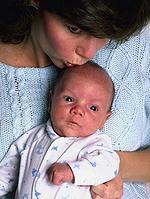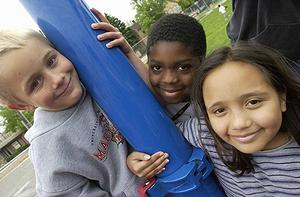Childhood Growth Stages Determine What Harm Pollution Does
GENEVA, Switzerland, July 27, 2007 (ENS) – An increased risk of cancer, heart and lung disease in adults can result from exposures to certain environmental chemicals during childhood, the World Health Organization said today. This finding is part of the first report ever issued by the agency focusing on children’s special susceptibility to harmful chemical exposures at different stages of their growth.
 Newborn
Newborn
Air and water contaminants, pesticides in food, lead in soil, as well many other environmental threats which alter the delicate organism of a growing child may cause or worsen disease and induce developmental problems, said the World Health Organization, WHO, releasing the report at its Geneva headquarters.
The peer-reviewed report highlights the fact that in children, the stage in their development when exposure to a threat occurs may be just as important as the magnitude of the exposure.
“Children are not just small adults,” said Dr. Terri Damstra, team leader for WHO’s Interregional Research Unit. “Children are especially vulnerable and respond differently from adults when exposed to environmental factors – and this response may differ according to the different periods of development they are going through.”
“For example, their lungs are not fully developed at birth, or even at the age of eight, and lung maturation may be altered by air pollutants that induce acute respiratory effects in childhood and may be the origin of chronic respiratory disease later in life,” Dr. Damstra said.
Over 30 percent of the global burden of disease in children can be attributed to environmental factors, the WHO study found.
 Young children
Young children
The global health body said this report is the most comprehensive work yet undertaken on the scientific principles to be considered in assessing health risks in children.
The work was undertaken by an advisory group of 24 scientific experts, representing 18 countries. They were convened by WHO to provide insight, expertise, and guidance, and to ensure scientific accuracy and objectivity. Once the text was finalized, it was sent to more than 100 contact points throughout the world for review and comment, and also made available on WHO’s International Programme of Chemical Safety website for external review and comment.
The central focus of the study is on the child from embryo through adolescence and on the need to have a good understanding of the interactions between exposure, biological susceptibility, and socioeconomic and nutritional factors at each stage of a child’s development.
The scientific principles proposed in the document for evaluating environmental health risks in children will help the health sector, researchers and policy makers to protect children of all ages through improved risk assessments, appropriate interventions and focused research to become healthy adults.
Children have different susceptibilities during different life stages, due to their dynamic growth and developmental processes, the authors said.
 Teens
Teens
Health effects resulting from developmental exposures prenatally and at birth may include miscarriage, still birth, low birth weight and birth defects.
Young children may die or develop asthma, neurobehavioral and immune impairment. Adolescents may experience precocious or delayed puberty.
The vulnerability of children is increased in degraded and poor environments, the report confirms. Neglected and malnourished children suffer the most. These children often live in unhealthy housing, lack clean water and sanitation services, and have limited access to health care and education.
For example, lead is known to be more toxic to children whose diets are deficient in calories, iron and calcium.
WHO warns, “One in five children in the poorest parts of the world will not live longer than their fifth birthday – mainly because of environment-related diseases.”
This new volume of the Environmental Health Criteria series, Principles for Evaluating Health Risks in Children Associated with Exposure to Chemicals, is online here.
